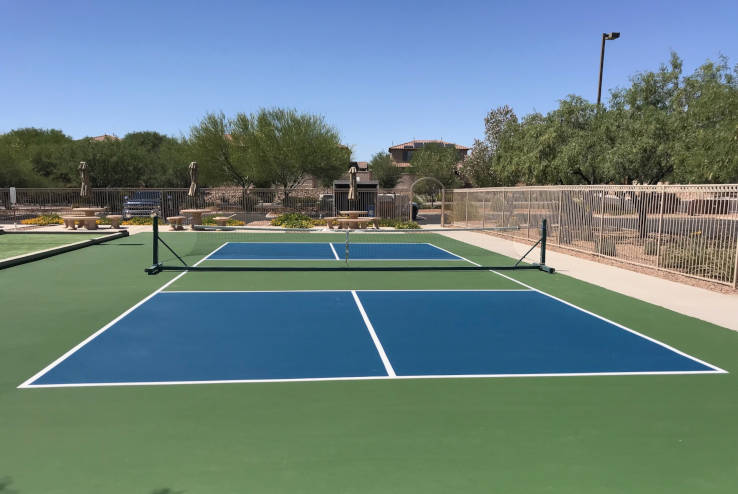How Local Regulations Influence Your Pickleball Court Construction Plans
How Local Regulations Influence Your Pickleball Court Construction Plans
Blog Article
Navigating Rules for Pickleball Court Building in Your Location
Building a pickleball court in your location needs a nuanced understanding of various regional laws, consisting of zoning regulations, building licenses, and safety criteria. Each municipality imposes details standards that can dramatically influence the expediency of your project. Engaging with local authorities and the neighborhood is crucial for making certain conformity and cultivating support. However, navigating this regulatory landscape can be intricate and time-consuming. What are the key steps you should consider to avoid prospective pitfalls and make certain a smooth construction procedure?
Comprehending Neighborhood Zoning Regulations
When considering the construction of a pickleball court, recognizing local zoning legislations is critical to making certain conformity and avoiding potential legal problems. Zoning laws dictate exactly how land can be made use of and often include specs pertaining to leisure facilities. These legislations can differ considerably by community, influencing variables such as court placement, noise, lights, and size degrees.
Prior to initiating building and construction, it is important to consult the local zoning board or preparation division to determine the particular regulations that apply to your residential property. Particular areas may limit entertainment tasks, while others may require certain authorizations or adherence to certain guidelines. It is likewise important to think about problems, which identify just how much frameworks must be from property lines or various other structures.
In addition, private developments, such as home owner organizations (HOAs), may impose their own rules pertaining to the building and use of pickleball courts. Comprehending these policies can prevent pricey adjustments or litigation down the line. Engaging with neighborhood stakeholders and neighborhood participants can offer beneficial insights and foster assistance for your job, ensuring that it straightens with the neighborhood's needs and assumptions.
Acquiring Necessary Building Allows
How does one navigate the intricacies of obtaining needed building authorizations for a pickleball court? The procedure starts with comprehending neighborhood policies and needs stated by municipal authorities. Typically, you will certainly require to submit a detailed site strategy that describes the proposed court measurements, materials, and design. This plan must follow zoning legislations and any type of details policies relating to entertainment facilities.

When authorizations are obtained, it is important to follow any type of examination schedules and requirements throughout the building phase. Keeping interaction with local authorities will assist in a smoother approval procedure and aid stay clear of potential problems. By thoroughly preparing and comprehending the permitting landscape, you can effectively browse the intricacies associated with constructing a pickleball court while remaining compliant with all local guidelines.

Assessing Environmental Impact
A detailed assessment of ecological impact is necessary when planning the construction of a pickleball court. This examination aids identify prospective results on regional communities, water sources, and area aesthetic appeals. Trick variables to consider consist of site choice-- making sure that the court is not constructed on ecologically sensitive land, such as wetlands or environments for threatened varieties
Soil stability and drainage patterns ought to see this be assessed to avoid disintegration and water merging, which can adversely influence surrounding vegetation and wildlife. Furthermore, the option of materials is essential; going with sustainable and green choices minimizes environmental harm.
The implementation of efficient stormwater administration practices is one more essential element, as it aids minimize drainage and sedimentation. Involving with regional ecological firms can give beneficial understandings right into laws and best practices details to your location.
Finally, community input can be helpful in recognizing any kind of neighborhood environmental worries and promoting support for the project. By performing a comprehensive environmental impact assessment, stakeholders can make certain that pickleball court building and construction straightens with sustainable practices and contributes favorably to the area's eco-friendly health and wellness.
Adhering To Safety Standards
Making sure conformity with safety and security requirements is important for the successful building and construction and operation of a pickleball court. Adhering to well established safety laws lessens the danger of injuries and mishaps, guaranteeing a safe and secure atmosphere for players.
Trick security criteria include correct court measurements, surface area materials, and lighting needs. The court must fulfill the main measurements of 20 feet broad by 44 feet long for doubles play, with appropriate barrier areas to stop injuries from wayward balls. Pickleball court construction. The surface ought to be constructed from non-slip materials to enhance grip and reduce the probability of falls
Additionally, illumination has to be sufficient for evening play, giving uniform lighting to Learn More stay clear of darkness that can hinder exposure. Neighborhood building ordinance may also determine details requirements for secure fencing and net elevation to make sure gamer security and prevent unauthorized accessibility to the court area.
Normal examinations and upkeep are essential to support these standards gradually. By focusing on security conformity, court owners not only secure players however likewise foster a favorable reputation within the area. This dedication to safety and security can encourage greater involvement and satisfaction of the sporting activity, inevitably adding to its development and sustainability.

Engaging the Area in Planning
Area involvement in the planning phases of pickleball court construction can substantially boost the project's overall success. Engaging neighborhood residents and stakeholders fosters a sense of ownership and encourages joint decision-making, which can bring about broader support for the initiative.
To successfully include the area, coordinators should initiate public meetings or workshops, giving a system for residents to voice their opinions and preferences regarding place, style, and features. Studies and comments types can additionally be used to collect insights from a larger audience, guaranteeing that varied viewpoints are taken into consideration.
Additionally, developing a neighborhood board of advisers can facilitate ongoing discussions and address concerns throughout the preparation process. This board can include representatives from numerous demographics, such as neighborhood institutions, leisure companies, and community associations, thus intensifying area depiction.
Efficient communication is key; updates concerning the task should be frequently shared through newsletters, social media, or regional notices. By focusing on area involvement, coordinators can grow enthusiasm, mitigate prospective opposition, and develop a pickleball facility that absolutely resonates check out this site with neighborhood values and demands. This joint technique not just improves the job but additionally reinforces neighborhood connections.
Final Thought
Finally, browsing the intricacies of pickleball court construction demands an extensive understanding of neighborhood policies, including zoning regulations, building licenses, and safety and security criteria. Performing ecological assessments is necessary to reduce eco-friendly impact, while neighborhood engagement can improve assistance for such projects. By adhering to these standards and promoting collaboration, effective execution of pickleball courts can be achieved, promoting leisure opportunities and area wellness. Proceeded persistance in these areas will certainly guarantee sustainable and certified advancement.
Constructing a pickleball court in your area requires a nuanced understanding of various neighborhood regulations, including zoning laws, building permits, and safety criteria.When considering the building of a pickleball court, understanding local zoning laws is essential to making certain compliance and avoiding possible lawful problems. By thoroughly preparing and understanding the permitting landscape, you can efficiently browse the complexities involved in constructing a pickleball court while staying compliant with all neighborhood laws.
In final thought, browsing the complexities of pickleball court construction requires an extensive understanding of local regulations, including zoning legislations, building authorizations, and security standards. By sticking to these standards and promoting collaboration, effective application of pickleball courts can be achieved, advertising entertainment possibilities and neighborhood well-being.
Report this page